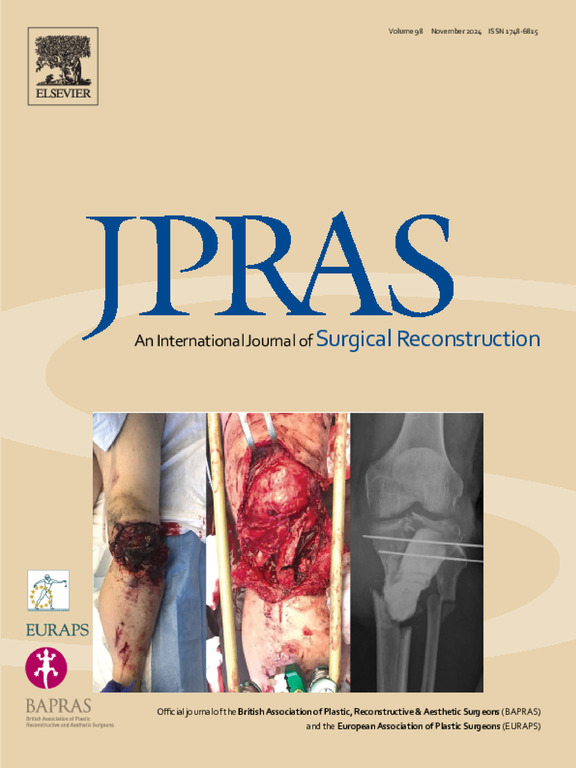成骨率和二次牙槽骨移植成功率:三维体积预测价值。
IF 2.4
3区 医学
Q2 SURGERY
Journal of Plastic Reconstructive and Aesthetic Surgery
Pub Date : 2025-07-01
DOI:10.1016/j.bjps.2025.06.029
引用次数: 0
摘要
背景:二次牙槽骨移植(SABG)是恢复牙槽骨裂患者解剖完整性和功能能力的关键干预措施。尽管手术技术和影像学有了进步,但评估术后预后的最佳指标仍不明确。方法:回顾性分析2016年至2023年间126例单侧牙槽裂行SABG的患者。利用术前和术后6个月颅面CT数据,采用三维体积分析计算术前骨缺损体积、术后残余骨缺损体积、成骨体积和成骨率。手术成功的定义是基于影像学的标准评估垂直高度、唇腭宽度和鼻底对称性。采用受试者工作特征(ROC)曲线分析评价各三维指标的预后表现。结果:平均成骨率为0.48±0.16,阈值为0.507,诊断准确率最高(AUC = 0.921;敏感性= 0.894,特异性= 0.785)。在所有评估的参数中,成骨率显示出SABG成功的最强预测能力。然而,它缺乏骨连续性和颊腭厚度的直接表征。结论:成骨率是评估SABG预后的可靠、有效的预后指标。然而,它应该与结构和临床指标一起解释,以确保全面评价。将体积和形态评估纳入多模式框架可以提高临床决策和长期治疗的成功。本文章由计算机程序翻译,如有差异,请以英文原文为准。
Osteogenesis rate and success of secondary alveolar bone grafting: A 3D volumetric prognostic value
Background
Secondary alveolar bone grafting (SABG) is a critical intervention for restoring anatomical integrity and functional capacity in patients with alveolar clefts. Despite advancements in surgical techniques and imaging, the optimal indicator for postoperative outcome evaluation remains undefined.
Methods
In this retrospective study, 126 patients with unilateral alveolar clefts who underwent SABG between 2016 and 2023 were analyzed. Preoperative and six-month postoperative craniofacial CT data were used to calculate preoperative bone defect volume, residual postoperative bone defect volume, osteogenesis volume, and osteogenesis rate using three-dimensional volumetric analysis. Surgical success was defined by imaging-based criteria assessing vertical height, labiopalatal width, and nasal floor symmetry. Receiver operating characteristic (ROC) curve analysis was employed to evaluate the prognostic performance of each 3D metric.
Results
The mean osteogenesis rate was 0.48±0.16, with a threshold of 0.507 yielding the highest diagnostic accuracy (AUC = 0.921; sensitivity = 0.894, specificity = 0.785). Among all evaluated parameters, osteogenesis rate demonstrated the strongest predictive capability for SABG success. However, it lacked direct representation of bone continuity and buccopalatal thickness.
Conclusion
Osteogenesis rate is a reliable and efficient prognostic marker for assessing SABG outcomes. Nevertheless, it should be interpreted alongside structural and clinical indicators to ensure comprehensive evaluation. Incorporating volumetric and morphological assessments into a multimodal framework may enhance clinical decision-making and long-term treatment success.
求助全文
通过发布文献求助,成功后即可免费获取论文全文。
去求助
来源期刊
CiteScore
3.10
自引率
11.10%
发文量
578
审稿时长
3.5 months
期刊介绍:
JPRAS An International Journal of Surgical Reconstruction is one of the world''s leading international journals, covering all the reconstructive and aesthetic aspects of plastic surgery.
The journal presents the latest surgical procedures with audit and outcome studies of new and established techniques in plastic surgery including: cleft lip and palate and other heads and neck surgery, hand surgery, lower limb trauma, burns, skin cancer, breast surgery and aesthetic surgery.

 求助内容:
求助内容: 应助结果提醒方式:
应助结果提醒方式:


